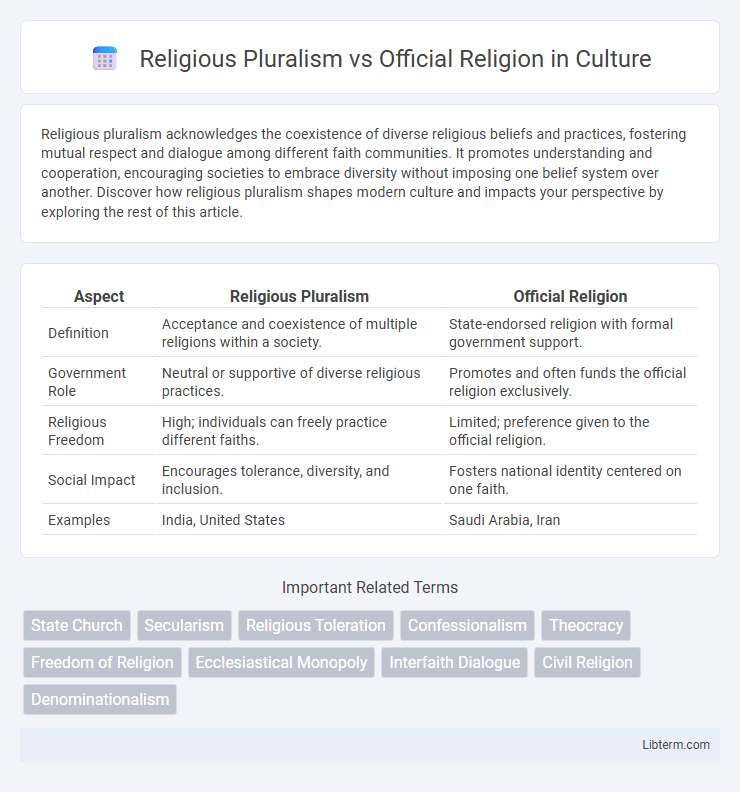Religious pluralism acknowledges the coexistence of diverse religious beliefs and practices, fostering mutual respect and dialogue among different faith communities. It promotes understanding and cooperation, encouraging societies to embrace diversity without imposing one belief system over another. Discover how religious pluralism shapes modern culture and impacts your perspective by exploring the rest of this article.
Table of Comparison
| Aspect | Religious Pluralism | Official Religion |
|---|---|---|
| Definition | Acceptance and coexistence of multiple religions within a society. | State-endorsed religion with formal government support. |
| Government Role | Neutral or supportive of diverse religious practices. | Promotes and often funds the official religion exclusively. |
| Religious Freedom | High; individuals can freely practice different faiths. | Limited; preference given to the official religion. |
| Social Impact | Encourages tolerance, diversity, and inclusion. | Fosters national identity centered on one faith. |
| Examples | India, United States | Saudi Arabia, Iran |
Defining Religious Pluralism and Official Religion
Religious pluralism refers to a societal framework where multiple religious beliefs coexist with mutual respect and equal legal recognition, fostering an environment of religious diversity and freedom. An official religion, by contrast, is a faith formally endorsed and often supported by the state, granting it privileged status over other religious groups within the country. The key distinction lies in the official religion's integration into government functions and laws, whereas religious pluralism emphasizes inclusivity and equal rights for all religious communities.
Historical Contexts of State Religion
Historical contexts of state religion reveal diverse approaches to religious pluralism, where some empires like the Roman Empire initially incorporated multiple deities before adopting Christianity as the official religion under Constantine. In contrast, Islamic caliphates historically combined religious authority with political power, enforcing a state religion while allowing certain protections for religious minorities under dhimmi status. Modern constitutional states often reflect a shift from official religions to secular governance, accommodating pluralistic societies by separating church and state to various degrees.
Philosophical Foundations of Religious Tolerance
Philosophical foundations of religious tolerance emphasize respect for diverse beliefs, rooted in Enlightenment principles advocating individual freedom and moral autonomy. Religious pluralism recognizes the coexistence of multiple faiths within a society without privileging any single belief system, fostering mutual understanding and dialogue. Official religion frameworks often challenge this tolerance by institutionalizing a dominant faith, potentially limiting equal religious expression and restricting minority rights.
Legal Frameworks: Constitutions and Religious Freedom
Legal frameworks in countries with religious pluralism often enshrine freedom of religion within their constitutions, ensuring individuals can practice diverse faiths without discrimination. Constitutions in these nations typically prohibit the establishment of an official religion, promoting equal status for multiple religious communities under the law. In contrast, countries with an official religion may embed state endorsement of a particular faith in their charters, potentially limiting the scope of religious freedom for minority groups.
Social Impacts of Official Religions
Official religions often shape national identity and cultural norms, influencing social cohesion and public policies. Their dominance can marginalize minority faiths, leading to social exclusion or tension within diverse populations. However, official religions also provide a unified moral framework that can enhance social stability and collective values.
Interfaith Dialogue and Pluralistic Societies
Religious pluralism fosters interfaith dialogue by encouraging mutual respect and understanding among diverse faith communities within pluralistic societies, promoting social cohesion and peaceful coexistence. Official religions often shape state policies, which can either support or restrict interfaith engagement, influencing the inclusivity of religious minorities. Effective interfaith dialogue in pluralistic societies contributes to reducing religious conflicts and enhancing collaborative efforts for social justice and human rights.
Case Studies: Countries Embracing Pluralism
Countries like India, Canada, and South Africa exemplify successful religious pluralism by constitutionally recognizing multiple faiths and protecting freedom of worship. These nations implement inclusive policies that promote interfaith dialogue and prevent discrimination based on religion, contributing to social harmony and national unity. Their legal frameworks balance diverse religious identities without endorsing a single official religion, fostering coexistence in multicultural societies.
Challenges of Religious Exclusivity
Religious exclusivity often leads to significant challenges in societies with religious pluralism, including social polarization, discrimination, and conflict among diverse faith communities. Official religions may impose legal and cultural restrictions that marginalize minority groups, limiting their freedom of worship and expression. This exclusivity can hinder social cohesion and impede the development of inclusive policies that respect and protect religious diversity.
Benefits of Religious Diversity in Governance
Religious pluralism in governance fosters social cohesion by ensuring equal representation and respect for diverse faith communities, which enhances political stability and reduces conflicts. Integrating multiple religious perspectives promotes inclusive policymaking that reflects a broader range of values and ethical considerations, leading to more equitable legislation. Countries embracing religious diversity often experience improved human rights protections and increased civic participation, strengthening democratic institutions and social harmony.
Future Trends in Religion-State Relations
Future trends in religion-state relations signal a shift toward increased religious pluralism, with more countries adopting policies that recognize multiple faiths rather than maintaining a single official religion. Technological advancements and globalization facilitate interfaith dialogue and legal reforms promoting equal religious rights, challenging traditional state-endorsed religions. Emerging frameworks emphasize secular governance models that accommodate diverse religious identities while ensuring freedom of belief and preventing religious discrimination.
Religious Pluralism Infographic

 libterm.com
libterm.com